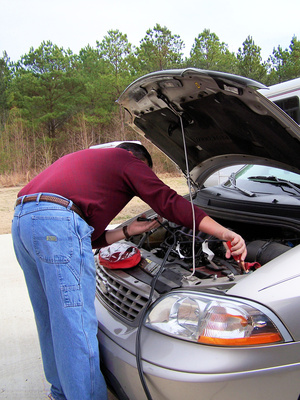
If your 2000 Ford Windstar won't start, the problem falls into one of two categories. The first category is if the engine will not crank, and the second is if the engine cranks but does not start. If the engine does not crank, the most likely cause is the battery and electrical system. If the engine cranks but does not start, there may be a problem in the fuel delivery system. Seek a qualified mechanic if you are not confident in making these repairs on your own.
Open the hood and prop it open with the prop rod. Verify that the battery cables and terminals are tight and free of corrosion, oil and dirt. Check that the chassis ground terminals are secure and free of corrosion, oil and dirt. If the connections are dirty or corroded, use a wire brush to clean the battery terminals and cable connectors. Tighten all loose connections.
Start the engine. Use a digital voltmeter to measure the voltage across the battery terminals. Turn the digital voltmeter to the DC setting. Place the red probe on the positive battery terminal and place the black probe on the negative battery chassis ground connection. The voltage should be approximately 12.8 volts. If the voltage is less than 12.8 volts, there is a problem in the battery or the charging circuit. Charge the battery then try starting the car again. If this does not resolve the issue, repair or replace the alternator or wiring.
Measure the voltage at the starter solenoid while cranking the engine. The voltage should be approximately 12 volts. If the voltage is 12 volts, there may be an issue with the starter. Locate the starter relay by following the starter solenoid wires back to the firewall. Turn the ignition key on but do not crank the engine and measure the voltage across the relay coil wire. The voltage should be approximately 12 volts. If the voltage is correct and the starter does not operate, replace the starter relay.
Turn the engine off. Remove and inspect the fuel filter. A dirty fuel filter will limit the amount of fuel delivered to the cylinders. Replace the filter if necessary. If the engine still will not start, have a qualified technician look at the engine. There may be an internal problem in the fuel delivery system. The technician will use an electronic service tool to monitor the engine sensors, engine timing and electronic control module. The data collected from the electronic service tool will aid the technician in diagnosing the problem.